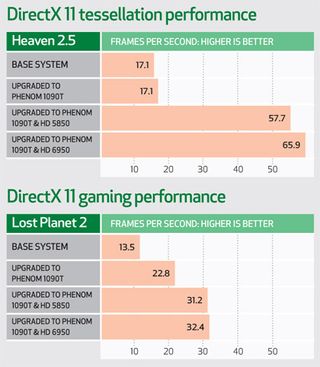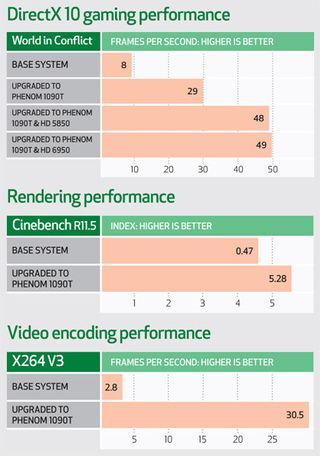Is it worth upgrading your old PC for gaming?
We benchmark old vs new to see if upgrading makes sense

Now then, time to get serious. All we've learned from our mucking about upgrading this and that is that what we really need is to fit a decent processor - and our motherboard is too old for that. So it's time to change the board.
Since this is a biggish job, there's no sense in aiming too low. We went straight for a six-core Phenom II 1090T. At about £150 a pop, they're not cheap, but we'd finally have oodles of six-core power. Our new board was an Asus M4A89GTD Pro, about £90 worth and capable of interesting overclocking experiments. On top of this, we'd need new memory: a pair of 2GB DDR3 sticks added £32-ish. All this brings the bill to about £250 - about half the cost of a modest new PC.
Remember, we're still running everything under XP with a pedestrian 512MB graphics card. Heaven 2.5 once more refuses to budge. It doesn't matter how much processing power you throw onto the board, it's all about the graphics card here.
3DMark06, which is much more skewed to CPU power, at last gets a decent hit, nearly doubling. The two CPU benchmarks, as you might have guessed, go ballistic. It all goes to show just how fast processor development is; a decent modern chip will absolutely slaughter the old guard. The machine also feels completely different at the desktop, nice and responsive.
Right, we've spent £250 and started to get interesting scores, but now our system is unbalanced again. Where once it needed processing power to match the card, now it desperately needs graphical power. So it's back to our HD 5850 and 6950 cards and more furious benchmarking to see whether we can at last get some decent chuffin' results. Which we can.
The HD 5850 finally has a chance to run and we have, ladies and gentlemen, boys and girls, decent playable speeds. The 3DMark06 benchmark nearly doubles again and Heaven more than doubles.
The game benchmarks start responding, too. At last, our upgrade candidate is a games machine, which is just as well as we've now spent £350 and it's still running an obsolete OS on an IDE hard drive.
Get daily insight, inspiration and deals in your inbox
Get the hottest deals available in your inbox plus news, reviews, opinion, analysis and more from the TechRadar team.
Smart money
Spending another ton to move to an HD 6950 doesn't repeat the trick, though. Since we're sticking to our original resolutions of 1,280x1,024, it doesn't have a chance to flex its GPU muscles. At these more sedate dimensions, and with no 64-bit drivers, it's not much better than its older cousin.
Again, spending the extra here would be something of a waste, which did surprise us a little - we expected more for our money now it was on a decent board.
The law of diminishing returns is in full effect in the world of graphics cards, and those last few frames get costly. We were really tempted to combine the Windows and drive upgrades with the processor and motherboard and graphics card upgrades to see what the result would be. At least, we were until we started adding up the figures and realised that way madness lay.
At this point, all that would have been left of our original box would be the case, power supply and optical drive, and our upgrade would have set us back about £500. This isn't really an upgrade, it's building a whole new rig. Time to calm down and think again.
Upgrading is one of the PC's great advantages, but it's a fast-moving field and machines are quickly left behind. To be realistic, after more than a couple of modest upgrades of an ageing computer, it's time to stop and think carefully about what you want the machine to do. It's possible to waste quite a lot of money on something that's never really going to perform well enough to justify the subsequent lightness of your wallet.

This is the big upgrade. It's also the most expensive, but it doesn't half make a difference. Suddenly, our tired old rig has a spring in its step. Although it needs a new graphics card to carry the extra power right through to the game frame rates, we're at last in decent, playable territory.
We jolly well should be, as it's cost £350 to change the board, chip and memory, and add an HD 5850. Notice that stretching another £100 to the 6950 again proves to be a waste, at these resolutions anyway (1,280x1,024).


Conclusion
So we've answered our original question. Yes, you can turn an old dog into a gaming machine - of course you can. You just can't do it without spending rather a lot of money and replacing nearly everything, making your old PC a bit of a Trigger's Broom (or Ship of Theseus, if you're more classically minded).
Once upon a time, you could beat the system by building rigs out of bits and it would be cheaper. Even if you had only a couple of major components, it was worth buying the rest separately. Those days are long gone.
Today, margins are tight, competition fierce and progress rapid. You'll rarely put together a decent system out of separates and save money. The same goes for any major upgrading. The balance between processor and graphics card is all-important: too much either way is wasted effort.
And watch those resolutions, too. If you don't run a big monitor then many high-power cards aren't as attractive as they think they are. For instance, witness our 5850 and 6950 scores with the Phenom 1090T at 1,280x1,024 - is that really worth £100 to you?
The PC is made of parts, but works as a whole, and you need to upgrade it with this in mind. The cost of fitting fast, modern kit is dissipated unless all of the sub-systems can cope. This effectively means that any serious upgrade means a new board, chip, graphics and RAM. And at this point you need to consider costs carefully.
Looking again at our original test system, all we can really recommend is adding another GB of RAM and hunting down an Athlon 64 chip. This would cost a reasonable £31 and gives a little boost all round - nothing spectacular, but the desktop feels much more lively and you get a few frames a second more here and there.
Maybe scouring other piles of old hardware or eBay for a better graphics card would be worth it, but getting serious about upgrading it proved to be an expensive and frustrating experiment.
Drive time
The only upgrade that really worked was the hard drive. Switching to a modern SATA drive had an immediate effect and, although not speeding up games as such, made everything feel more lively. You can never have too much storage, either, and drives are easy to transfer between systems.
You can get a lovely, all-shiny, all-new, all-sorted-out proper games rig for £750 (take a look at Chillblast's Fusion Rocket). You'll get a nice new version of Windows, too, plus big, fast drives, a new keyboard that isn't full of crumbs, and a new mouse and all the rest.
It pains us to say it, but it's worth saving up and getting a new box if you're more than a couple of years behind the curve. It's tempting to think that you can upgrade some faithful old PC you found hidden away somewhere into a games box, but once you've passed a certain point it's time to take the old fellow out for a long walk, with a spade in one hand and a shotgun in the other.
Most Popular

